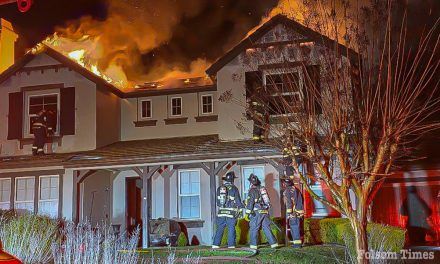Fire Chief expects to close open lands ahead, cites importance of defensible space
The official fire season has been well underway locally since last month but has gotten off to a mild start around the City of Folsom so far. That will change this this week as the first triple digit temperatures of the season arrive. The higher temperatures will turn up the heat on local fire danger, and the Folsom Fire Department is well prepared for a season that local officials foresee as keeping them busy and being pretty typical of past seasons.
“This year is going be pretty typical of past years, with the exception of last year when we had so much rain and flooding up into springtime,” Folsom Fire Chief Ken Cusano as he sat down with Folsom Times to talk fire season awareness. “We did get some later rains that tends to make the grasses a little bit taller but for the most part, I think statewide it’s going to be a pretty standard type of year.”
When Cusano refers to the season as being typical, that doesn’t mean it will be a mild year for fires and fire danger. While vegetation fires within the City of Folsom have been far and few in recent weeks, other areas have already had their share of vegetation fires, including El Dorado Hills, Rancho Cordova and beyond. Over the weekend a large fire in San Joaquin County quickly grew to more than 12,000 acres and prompted evacuations.
Cusano’s department is well prepared for the busy weeks ahead to keep Folsom safe. He credits the City of Folsom’s weed abatement program as a big contributor when it comes to reducing fire risk in the city limits and across city owned lands.
“Around here we have a lot of light flashy fuels, which is vegetation such as tall grasses, that type of fuel can ignite easily and take off very fast,” he explained. “Here in the city we try our best to do our part with the weed abatement and vegetation management.”
The Folsom Fire Department relies on other city departments when it comes to keeping Folsom as fire safe as possible, especially when it comes to the open lands owned by the city where heavy vegetation is common. From city workers pushing mowers and trimmers, to four legged fire fuel eaters, the program greatly reduces the risk of fire in the area as well as the risk of fire spread, should one ignite.
“The Parks and Recreation Department takes care of all our city owned properties and they have been busy already doing a good amount of mowing and weed abatement,” said Cusano. “And I’m sure everyone has seen the goats and sheep out there eating down our fields already.”
The City of Folsom has more than 980 acres of city-owned open space, and of that, about 300 acres are weed abated each year to achieve the required fire safety interface between residential structures and open spaces.
Back in 2022, Cusano launched a program in the city that began as an emergency declaration and then developed into the modification of a city ordinance allowing the fire chief to close public access to city owned lands where the presence of a high fire danger has been determined. The program was very effective. After nearly four dozen vegetation fires early in the season of 2021, the closure greatly reduced the amount of fires thereafter in the season that had already gotten underway. Last year, the closure took place earlier in the season and the department saw far less significant incidents, a number Cusano said you could count by hand.
Will Folsom’s open lands that pose a fire risk be closed again this season? According to Cusano, they will and it could come very soon as they make the decision based on conditions.
“We will be likely closing down our open spaces within the city limits to the public very soon,” said Cusano. “We won’t be closing down the bikes trails or anything like that, those will still be accessible. We will be closing down the open spaces around many of them just like before. Nobody really has any business being back in those areas this time of year when fire danger is on the rise. Most fire are started by humans, so it greatly reduces our risk.”
The future closures will prohibit all members of the public from trekking into the declared wild land spaces, the areas will be clearly marked with signage. This means some things like off-trail hikes will not be permitted in marked areas and it certainly means no camping or residing in those areas will be permitted.
“Many of the fires we have in those types of areas are caused by those who are camping out or living in those areas,” Cusano said. “And when those types of fires start, they pose a variety of dangers, not only to property but our firefighters have to be mindful of what types of items can be in an encampment, it’s not something we want to send anyone directly into if we can prevent it. But it’s not just that, it’s a combination of things that can light a fire in those areas, a simple cigarette ember can cause it. Either way you look at it, it’s usually human related so keeping people from walking out in a dry field for no reason is just the smart thing to do for everyone.
At this time, Cusano does not have a firm date of when such closures will take place and exactly which areas will be included, but it could come very soon. The closures will be clearly communicated with residents letting them know when and where they will be enacted.
When it comes to keeping your home and property safe, this year is no different than others where preparation and prevention are important for everyone to practice. In a community like Folsom, where many homes a very close together, everyone doing their part can help an entire community should a fire start in the area.
“Clearing out any type of combustible type of stuff against your house, especially within the first five feet of the structure can help tremendously,” Cusano said. “Some of the houses here are very close together and if something gets going it doesn’t take much to spread to another one so limiting combustibles from potential exposure can help a great deal.”
The City of Folsom requires a minimum defensible space of 30 feet from structures or property lines, which the Fire Chief may increase to 100 feet in high-hazard areas, applicable to both City-owned and private properties.
Private property owners are required to adopt weed abatement practices to maintain community safety. These practices involve removing flammable vegetation and establishing defensible spaces around properties to prevent fire spread, with all abatements to be completed by June 1 annually. Inspections are carried out by the Folsom Fire Department on vacant lots and by Folsom Code Enforcement on residential properties to ensure compliance and enhance safety against wildfires.
The defensible space is broken down into zones to help educate residents as to how they should be prepared. The zones are as follows:
Zone 0 is the Ember Resistant Zone and extends 5 feet from buildings, structures, decks, etc.
While not legally required yet, Zone 0 is key for wildfire defense and preventing fires from spreading to your home. Here are the current guidelines:
Use gravel, pavers, or concrete instead of combustible mulch
Clear dead weeds, grass, and debris; check roofs, gutters, and outdoor areas
Keep branches trimmed 10 feet away from chimneys and stovepipes
Minimize combustible items like furniture and planters on decks
Move firewood and lumber to Zone 2 for safety
Replace combustible fencing and gates with fire-resistant materials
Shift garbage and recycling containers to a safer area outside this zone
Relocate boats, RVs, and vehicles away from this zone to reduce fire risks
Zone 1 is the lean clean and green zone extends 30 feet from buildings, structures, decks, etc. or to your property line, whichever is closer.
Clear all dead plants, grass, and weeds
Remove dead leaves and pine needles from your yard, roof, and gutters
Trim overhanging branches and keep them 10 feet from your chimney
Regularly trim trees to maintain a 10-foot gap from others
Move wood piles to Zone 2
Prune flammable plants and shrubs near windows
Clear flammable vegetation and items from under decks, balconies, and stairs
Maintain space between trees, shrubs, and flammable items like patio furniture and wood piles
Ensure outbuildings and LPG tanks have 10 feet of clear space to bare soil and no flammable vegetation within an additional 10 feet around them
Zone 2 is he Reduce Fuel Zone and extends from 30 feet to 100 feet out from buildings, structures, decks, etc. or to your property line, whichever is closer.
Trim annual grass to a maximum height of 4 inches
Space out shrubs and trees horizontally (See diagram)
Ensure vertical spacing between grass, shrubs, and trees (See diagram)
Remove fallen leaves, needles, and small branches, but can leave up to 3 inches
Keep exposed wood piles at least 10 feet clear from surroundings, down to the soil
Ensure outbuildings and LPG tanks have 10 feet of clear space to bare soil and no flammable vegetation within an additional 10 feet around them
Fire-resistant landscaping can be an important factor when it comes to being prepared for fire. This involves much more than basic yard maintenance. It combines plant selection and upkeep to help stop fire from reaching your home. With smart planning and regular care, you can create a beautiful, water-efficient, and fire-resistant landscape.
“A lot of people use shredded bark when it comes to landscaping, that is actually one of the easiest materials that can smolder unseen for days from an ignition source such as a tossed cigarette or even a short in a low voltage wiring connection beneath it. It doesn’t take much to spark it and it can eventually take off. We see that a lot, so making sure the dry vegetation is cleared around those areas is really important and keep materials from being up against your house. When it comes to landscaping, it’s usually the yards that are not kept up that end up having an issue.”
If residents notice an area in need of weed abatement, they can check the abatement schedules on the City of Folsomwebsite. Weed abatement requirements for Folsom property owners are listedonline. If resident is concerned about a weed abatement issue on vacant private property, they can email and report it to Michelle Toledo, Folsom’s Deputy Fire Marshal,mltoledo@folsom.ca.us.




